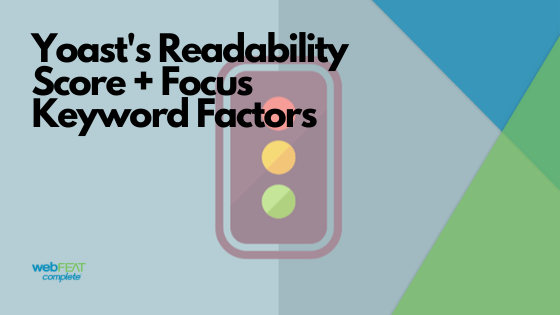If you’re new to Yoast’s SEO plugin within WordPress, you may be wondering, “Do the Yoast readability and focus keyword scores make a difference in the success of my page?” Well, there are a couple of ways you can look at that question. If you mean, “do they have a direct impact on my rankings,” the answer is no. If you mean, “do they use best practices as guidelines that, when followed, can improve your rankings,” the answer is yes. As an SEO, it’s easy to get in the habit of following these guidelines without giving them much thought, but if you’re a business owner or marketing manager who is unfamiliar with most SEO practices, you may have to do some research. Fortunately, all of the research you need to do is in this blog post!
Disclaimer: just because you follow the Yoast Readability and Focus Keyword guidelines on all pages/posts of your website does not mean that you will rank well. There are many, many other factors influencing rankings that someone who isn’t an SEO might not be aware of. However, by following their guidelines, you’ll probably have an advantage over a few competitors who aren’t doing any SEO at all.
Breaking down the Yoast Readability Score
What is it?

What Yoast sometimes refers to as the “Content Analysis Tool,” the readability score basically uses the “Flesch Reading Ease Test” and a few other factors (discussed below) to determine if your content is easy to read. The Flesch test takes into account average sentence length and the number of syllables per word to find a score that ranges from 0 to 100. The higher the score, the more readable the content is—categorized by grade level and age. Here are some example scores:
- 95: Easily understandable for someone in 5th grade—around 11 years old
- 65: Easily understandable for someone transitioning from middle to high school—13-15 years old
- 10: Easily understandable for a university graduate
Source: Readability Formulas
[fc id=’11’ align=’center’][/fc]
Given this information, some types of content should actually have a lower score, because your target audience may primarily consist of college graduates or the topic may be high-level. The bottom line here is that users are impatient. If content is long-winded and not broken up, it could have users heading back to the search results (known in the SEO world as “bouncing”) to look for a more concise answer to their question. This can have a negative impact on search presence over time.
Another readability formula that is commonly brought up in association with the Flesch test is the Gunning Fog Index (FOG). The FOG takes into account the average sentence length (just like Flesch) but the other factor is the percentage of hard words (words with 3 or more syllables). The ideal FOG score is a 7 or an 8. Scores above 12 are too hard for most people to read (Readability Formulas-FOG).
Additional Readability Factors
If your scores have been appearing as red and you’d like to make them green, use the “readability” tab under the “Yoast SEO” box in WordPress to review the analysis, what is bringing your score up and down. Here is an example:

Red: In this case, sentences include too many words and are using a passive voice. Yoast recommends that we balance the passive with more active phrases, and try to simplify sentences. Yoast feels that too much passive voice can be distant, and hard to understand.
Yellow: The yellow section indicates that paragraph blocks shouldn’t be too large. This speaks to the impatient user we discussed earlier. A big block of text may encourage a user to venture elsewhere on the internet to get answers or find what they’re looking for.
Green: Flesch Reading test score is good, words after subheadings is an appropriate length, and sentences contain transition words. Transition words are especially important because, without them, readers get lost in your writing.
Following these guidelines will help you create, evaluate and revise a piece of content to be easily readable, and it will prompt more users to stay on the page and engage.
Breaking Down the Yoast Focus Keyword Factors
What are focus keywords?
Focus keywords are the idea that you want your page built around. The primary purpose of the focus keyword is to help you stay on track with your topic, and optimize your page or post around it. If you stray away from the topic, don’t use the correct verbiage, or create thin content, Yoast will give you a yellow or red score. Some of the factors Yoast gives you are just for general best practices too, not even truly focused on the keyword/search phrase. Let’s have a look:

How to pick a focus keyword
You should be able to pick a focus keyword or search phrase based upon the content of whatever you’re publishing. Primary pages should have a very clear focus keyword, but blog posts will need a longer-tail keyword to ensure the focus is different and doesn’t dilute the value of one of your primary pages. Canonicalization should be considered in these cases, but we’ll save that for another blog post. A good example would be if you owned a plumbing business. You’d probably have a page discussing drain cleaning. To drive traffic to the site and bring in more prospective clients, perhaps you wrote a blog titled “Drain Cleaning for Bathtubs—DIY.” The primary page that you want to drive traffic to is the drain cleaning one, which would have a focus keyword of “drain cleaning.” For the blog post, you may want your focus keyword to be “drain cleaning for bathtubs.” As you can see, these focus keywords often come pretty naturally.
There is a lot of discussion about focus keyword generators, and those are absolutely unnecessary. If you’re looking for content to build, just use the search results to find topics that folks are interested in. Make sure you tie it all together and serve intent, and you’ll be A-Okay. Also, don’t concern yourself with meta keywords. Those serve zero value to SEO efforts, and may even work against you. A focus keyword is just for guidance, a meta keyword is just an old tag that helped notify search engines what the topic of the page was. Google has become so smart that it hasn’t needed meta keywords for a while now.
Some of the key takeaways here:
- Write a good amount of content, but it shouldn’t be forced. If you look at many articles on the first page of Google, you’ll find that their content is robust. It’s not that it needs to be long, it just needs to be thorough.
- Whatever your topic is, make sure you maintain focus and mention it throughout the content (headings, copy, etc…) Don’t stuff the keyword, just use it naturally
- Be sure to link internally and externally
- Follow meta title and description character guidelines (meta title under 60 characters, description under 160 characters)
- Make sure your URL describes the content on the page
- Example: Plumbers.com/drain-cleaning-for-bathtubs vs. Plumbers.com/quer1111
- Use relevant images
By following Yoast’s guidelines consistently, you’ll receive a green rating and have a better opportunity to rank for more search phrases, and improve those rankings going forward.
Onward to Focused, Readable, Strong Content
I’m hopeful that this will be helpful to you as you create content in the future. Creating great content is time-consuming, but in the end it consistently drives traffic, satisfies users, and brings you more business. Our SEO Services rebuild, revise and create content that not only passes Yoast’s guidelines, but delivers results that make a difference. If you’re looking for additional advice on how to create content, or would like someone to handle that undertaking for you, please contact us or leave a comment below.
“”





